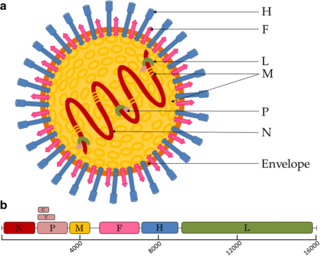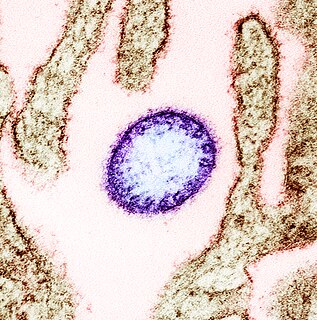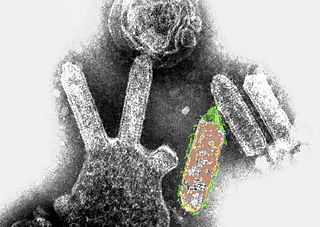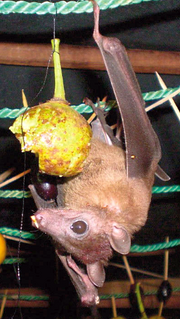
A zoonosis is an infectious disease caused by a pathogen that has jumped from an animal to a human. Typically, the first infected human transmits the infectious agent to at least one other human, who, in turn, infects others.

Megabats constitute the family Pteropodidae of the order Chiroptera (bats). They are also called fruit bats, Old World fruit bats, or—especially the genera Acerodon and Pteropus—flying foxes. They are the only member of the superfamily Pteropodoidea, which is one of two superfamilies in the suborder Yinpterochiroptera. Internal divisions of Pteropodidae have varied since subfamilies were first proposed in 1917. From three subfamilies in the 1917 classification, six are now recognized, along with various tribes. As of 2018, 197 species of megabat had been described.

Paramyxoviridae is a family of negative-strand RNA viruses in the order Mononegavirales. Vertebrates serve as natural hosts. Diseases associated with this family include measles, mumps, and respiratory tract infections. The family has four subfamilies, 17 genera, and 78 species, three genera of which are unassigned to a subfamily.

Henipavirus is a genus of negative-strand RNA viruses in the family Paramyxoviridae, order Mononegavirales containing five species. Henipaviruses are naturally harboured by pteropid fruit bats and microbats of several species. Henipaviruses are characterised by long genomes and a wide host range. Their recent emergence as zoonotic pathogens capable of causing illness and death in domestic animals and humans is a cause of concern.
Menangle pararubulavirus, also called Menangle virus, is a virus that infects pigs, humans and bats.

In infectious disease ecology and epidemiology, a natural reservoir, also known as a disease reservoir or a reservoir of infection, is the population of organisms or the specific environment in which an infectious pathogen naturally lives and reproduces, or upon which the pathogen primarily depends for its survival. A reservoir is usually a living host of a certain species, such as an animal or a plant, inside of which a pathogen survives, often without causing disease for the reservoir itself. By some definitions a reservoir may also be an environment external to an organism, such as a volume of contaminated air or water.

Hendra virus, scientific name Hendra henipavirus, is a bat-borne virus that is associated with a highly fatal infection in horses and humans. Numerous disease outbreaks in Australia among horses have been caused by Hendra virus. The Hendra virus belongs to the genus Henipavirus, which also contains the Nipah virus, which has also caused disease outbreaks.

Nipah virus, scientific name Nipah henipavirus, is a bat-borne virus that causes Nipah virus infection in humans and other animals, a disease with a high mortality rate. Numerous disease outbreaks caused by Nipah virus have occurred in South and Southeast Asia. Nipah virus belongs to the genus Henipavirus along with the Hendra virus, which has also caused disease outbreaks.

Australian bat lyssavirus (ABLV), originally named Pteropid lyssavirus (PLV), is a zoonotic virus closely related to the rabies virus. It was first identified in a 5-month-old juvenile black flying fox collected near Ballina in northern New South Wales, Australia, in January 1995 during a national surveillance program for the recently identified Hendra virus. ABLV is the seventh member of the genus Lyssavirus and the only Lyssavirus member present in Australia.
Lagos bat lyssavirus, formerly Lagos bat virus (LBV) is a Lyssavirus of southern and central Africa that causes a rabies-like illness in mammals. It was first isolated from a fruit bat from Lagos Island, Nigeria in 1956. Brain samples from the bat showed poor cross-reactivity to rabies antibodies but the virus was found to be closely related to the rabies virus. This was the first discovery of a rabies-related virus. Until this time, rabies was thought to have a single causal agent.

Pteropus is a genus of megabats which are among the largest bats in the world. They are commonly known as fruit bats or flying foxes, among other colloquial names. They live in the South Asia, Southeast Asia, Australia, East Africa, and some oceanic islands in the Indian and Pacific Oceans. There are at least 60 extant species in the genus.

The large flying fox, also known as the greater flying fox, Malayan flying fox, Malaysian flying fox, large fruit bat, kalang, or kalong, is a southeast Asian species of megabat in the family Pteropodidae. Despite its scientific name, it feeds exclusively on fruits, nectar, and flowers, like the other flying foxes of the genus Pteropus. It is noted for being one of the largest bats. As with nearly all other Old World fruit bats, it lacks the ability to echolocate but compensates for it with well-developed eyesight.

The Madagascan rousette or Madagascar rousette, is a species of megabat in the family Pteropodidae endemic to Madagascar. Its natural habitat is subtropical or tropical dry forests. It is threatened by habitat loss.
Clarence James Peters, Jr is a physician, field virologist and former U.S. Army colonel. He is noted for his efforts in trying to stem epidemics of exotic infectious diseases such as the Ebola virus, Hanta virus and Rift Valley fever (RVF). He is an eminent authority on the virology, pathogenesis and epidemiology of hemorrhagic fever viruses.

Bat virome refers to the group of viruses associated with bats. Bats host a diverse array of viruses, including all seven types described by the Baltimore classification system: (I) double-stranded DNA viruses; (II) single-stranded DNA viruses; (III) double-stranded RNA viruses; (IV) positive-sense single-stranded RNA viruses; (V) negative-sense single-stranded RNA viruses; (VI) positive-sense single-stranded RNA viruses that replicate through a DNA intermediate; and (VII) double-stranded DNA viruses that replicate through a single-stranded RNA intermediate. The greatest share of bat-associated viruses identified as of 2020 are of type IV, in the family Coronaviridae.

A Nipah virus infection is a viral infection caused by the Nipah virus. Symptoms from infection vary from none to fever, cough, headache, shortness of breath, and confusion. This may worsen into a coma over a day or two, and 50% to 75% of those infected die. Complications can include inflammation of the brain and seizures following recovery.

The 2018 Kerala Nipah virus outbreak was an outbreak of the Nipah virus in India's southern state Kerala, traced to the fruit bats in the area. The outbreak was localized in Kozhikode and Malappuram districts of Kerala and claimed 17 lives, The outbreak was contained and declared over on 10 June 2018. This was the third Nipah Virus outbreak in India, the earlier being in 2001 and 2007, both in the eastern state West Bengal.

The 1998–1999 Malaysia Nipah virus outbreak was a Nipah virus outbreak occurred from September 1998 to May 1999 in the states of Perak, Negeri Sembilan and Selangor in Malaysia. A total of 265 cases of acute encephalitis with 105 deaths caused by the virus were reported in the three states throughout the outbreak. The Malaysian health authorities at the first thought Japanese encephalitis (JE) was the cause of infection which hampered the deployment of effective measures to prevent the spread before being finally identified by a local virologist from the Faculty of Medicine, University of Malaya that it was a newly discovered agent named Nipah virus (NiV). The disease was as deadly as the Ebola virus disease (EVD), but attacked the brain system instead of the blood vessels. University of Malaya's Faculty of Medicine and the University of Malaya Medical Centre played a major role in serving as a major referral centre for the outbreak, treating majority of the Nipah patients and was instrumental in isolating the novel virus and researched on its features.
Sosuga pararubulavirus is a species of Paramyxovirus which is transmissible to humans. The Egyptian fruit bat is thought to be a natural reservoir species for the virus.
Bat mumps orthorubulavirus, formerly Bat mumps rubulavirus (BMV), is a member of genus Orthorubulavirus, family Paramyxoviridae, and order Mononegavirales. Paramyxoviridae viruses were first isolated from bats using heminested PCR with degenerate primers. This process was then followed by Sanger sequencing. A specific location of this virus is not known because it was isolated from bats worldwide. Although multiple paramyxoviridae viruses have been isolated worldwide, BMV specifically has not been isolated thus far. However, BMV was detected in African fruit bats, but no infectious form has been isolated to date. It is known that BMV is transmitted through saliva in the respiratory system of bats. While the virus was considered its own species for a few years, phylogenetic analysis has since shown that it is a member of Mumps orthorubulavirus.












